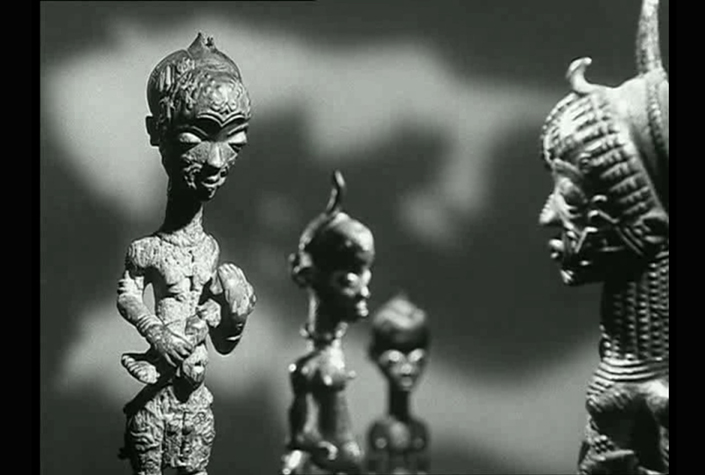Mining nature and humans to death
11/26/2024
7 min reading time
In the forthcoming Double Feature Florencia Levy offers insights into a dystopian world that is in fact our current world. Starting with a residency in China, which culminated for the artist in her being interrogated by the authorities, her video work “Fossil Place” focuses on an autonomous region in China. Because of the region’s rare earth and mineral deposits, the area is subject to massive human changes to nature through mining.
Lorem Ipsum
It is an image that seems to have originated in a dystopian sci-fi movie: Greyish brown, muddy earth; a sky buried under an impenetrable layer of smog; and in the background, almost unrecognizable, large smokestacks and industrial buildings. Nowhere are people, let alone flora and fauna, to be seen in this life-threatening environment. “Tierra de Ciervos” (Land of deer) is the name Argentine artist Florencia Levy chose for her photo, which she shot in 2016 from the top of the Weikuang Dam on the outer edge of the Chinese city of Baotou. In 2015, journalists labeled the zone surrounded by dams and some eight and one half square kilometers large where the local industries dump their toxic mining slurry from the rare earth mines nearby “hell on earth” or “the worst place on Earth”.
In 2016, the artist took the opportunity afforded by a residency in China to form her own opinion of the place, located in the southwest of the Inner Mongolia Autonomous Region, which is in the north central of the People’s Republic, and about 650km from Beijing. It was a research trip that had decidedly serious consequences: Levy was arrested by Chinese security force agents on the Weikuang Dam, questioned for several hours, and had to delete all the photographs she had taken there. “I thought I was going to die. They thought I was a spy,” she commented in retrospect in Argentine daily La Nación. As if by miracle, one photo survived on the memory card: “Tierra de Ciervos”.



Lorem Ipsum
Precisely the regions around the cities of Baotou and Ordos are particularly disgusting examples of such predatory mining of nature. The immense deposits of rare earths discovered there are being mined to enable our laptops, Smartphones, electric vehicles, and wind turbines to function. Mining them results in the radioactive waste and slurry polluted with heavy metals that gets piped as ‘tailings’ into the local artificial reservoir surrounded by the Weikuang Dam. Here, Chinese state capitalism untrammeled by any civic liberties meets up with the legacy of the Soviet Era, whose influence on Inner Mongolia can still be discerned in the architecture of Baotou. “What men want to learn from nature is how to use it in order wholly to dominate it and other men,” Adorno and Horkheimer wrote in their well-known essay collection “Dialectic of Enlightenment”, thus describing the ultimate consequence of unenlightened mastery of nature. In this way, Levy’s “Lugar fósil” becomes a swansong to that (economic) progress which, realized as an end in itself, destroys the very basis of life and completely subjugates humans and the nature that surrounds them. The echo of their lives can only be sensed in the masses of stone in Levy’s filmic work.
Alongside the video, Levy also presents a section from her work “Hundreds of Millions of Years for These Forms”, produced in 2023, which focuses on the phenomenon of deep-sea mining and is performed by a choir consisting of 12 posthuman entities. The text and the choir structure, created from computer-generated images, motion capture, and recordings of human voices, is based on interviews, scientific publications, and speculative fiction.

“Les statues meurent aussi” by Chris Marker and Alain Resnais
As the second film for the evening, Florencia Levy has chosen “Les statues meurent aussi” (Statues Also Die) by French filmmakers Chris Marker and Alain Resnais. The essayistic film produced in 1953 essentially takes up where Levy’s “Lugar fósil” ends. “If people die, they enter into history. If statues die, they become art. This botany of death is what we call culture,” the film tells us right at the beginning. The film was commissioned by Alioune Diop’s pan-African magazine “Présence Africaine” and devotes itself to the historical art and culture of Africa south of the Sahara in the museum context. Irritated by the fact that such art was exclusively exhibited in Paris’ anthropological Musée de l’Homme and not, for example, in an art museum such as the Louvre, during the preproduction of the film the directors adopted an ever more anti-colonialist vantage point, far more so than was according to Alain Resnais originally planned. In shots lasting several minutes, the film shows us expressively illuminated statues, sculptures, and masks, commenting emphatically on the relationship of art and culture, engages specifically in the latter third with the longevity of colonial perspectives. Owing to this innate criticism, shortly after it came out the film was censored by the French Ministry of Culture and was not to be viewed in its original length until 1968.


